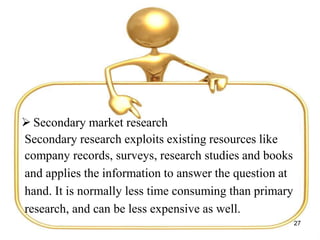market anlysis SOFTware.pptx
- 4. MARKET 4
- 5. MARKET • A market is defined as the sum total of all the buyers and sellers in the area or region under consideration. The area may be the Earth, or countries, regions, states, or cities. • The value, cost and price of items traded are as per forces of supply and demand in a market. The market may be a physical entity, or may be virtual. It may be local or global, perfect and imperfect. 5
- 6. MARKET ANALYSIS • A market analysis is the best way to get a third-party perspective of all of the best options for your marketing campaign, and to ensure that your marketing dollars are spent in the most effective way possible. • The goal of market analysis is to determine the attractiveness of a market and to understand its evolving opportunities and threats as they relate to the strength and weakness of the firm. 6
- 7. OBJECTIVES • Determine attractiveness of a market. • Find & identify new business opportunities. • Targeting and dividing the market into niche. • Positioning the products or brands in the mind of customers • Understand the dynamics of the market 7
- 8. WHY MARKET ANALYSIS ? • Market information • Insight into existing customers • Identifying potential customers • Customer need • Customer behaviour pattern • Identify business opportunity 8
- 9. • Competitor Analysis • Economic overview • Shift share analysis • Occupational changes • Strategic advantage • Resolving Business Problems 9
- 10. WHEN MARKET ANALYSIS? • Determining the sales potential of your products and services. • Attracting customers to your business • Selling to customers and earning repeat business 10
- 11. How MARKET ANALYSIS helps A market analysis answers these questions about your customers: • Who are they? • Where are they? • What do they need? • How do they make their buying decisions? • Where do they buy? • How do you reach them with your marketing and sales messages? 11
- 12. DIMENSIONS OF MARKET ANALYSIS • Market size (current and future) • Market segment • Market trends • Market growth rate • Market profitability • Industry cost structure • Distribution channels • Key success factors 12
- 13. MARKET SIZE • Total annual sales in the market served. • Current market size and future size. HOW TO DETERMINE MARKET SIZE? Govt. data. Trade associations. Financial data from major players. Customer survey. 13
- 14. MARKET SEGMENTS MARKET Geography and location Customer segments a) market in which we a) who buy our sell product b) local market or b) profile of target international market customer 14
- 15. MARKET TRENDS Once the segments of the product's market are determined, the market trends of the product needs to be analysed from time to time. Identify the trends in the market segments within which the product fits. If the market segment is growing and is projected to continue to grow, then it is an upward trend. If the trend is for new products then the company should replace older models, with new ones and that is called downward trend for the older products. 15
- 16. MARKET GROWTH RATE • Keep a track of the market condition. • Sales growth of complementary products. • Product life cycle phases can be understood. How to estimate the Market Growth Rate ?? Historical data Demographic information 16
- 17. MARKET PROFITABILITY • Profit potential for a market can be used as a guideline to determine how difficult it is to make money in the market. • Porter`s 5 forces identifies the 5 factors that effect the market profitability. 17
- 19. INDUSTRY COST STRUCTURE • Identifying key factors for success. • Porter's value chain model is useful for determining where value is added and for isolating the costs. • The cost structure also is helpful for formulating strategies to develop a competitive advantage. 19
- 20. 20
- 21. DISTRIBUTION CHANNELS The path through which goods and services travel from the vendor to the consumer . A distribution channel can be as short as a direct transaction from the vendor to the consumer, or may include several interconnected intermediaries along the way such as wholesalers, distributers, agents and retailers. 21
- 22. ANALYSING DISTRIBUTION CHANNEL • What are the alternative distribution channels • What are the trends, • what channels growing importance, • what new channels emerged or likely emerged 22
- 23. TYPES OF DISTRIBUTION CHANNELS Existing distribution channels Trends and emerging channels Channel power structure 23
- 24. KEY SUCCESS FACTOR • The key success factors are those elements that are necessary in order for the firm to achieve its marketing objectives. • Access to essential unique resources • Ability to achieve economies of scale • Access to distribution channels • Technological progress 24
- 25. PERFORMING MARKET ANALYSIS • Identify why a customer would buy your product. • Define your target market through segmentation. • Conduct market research. • Analyze the results of your research. • Incorporate your findings into strategic business decisions. 25
- 26. MARKET RESEARCH Market research can be of two types:- Primary Market research Primary research is original information gathered through your own efforts to respond to a specific question or set of questions. This information is normally gathered through surveys, observation, or experimentation. 26
- 27. Secondary market research Secondary research exploits existing resources like company records, surveys, research studies and books and applies the information to answer the question at hand. It is normally less time consuming than primary research, and can be less expensive as well. 27
- 28. CONCLUSION • Important to know your business inside and out. • Helps us to stick to the concept of describing the market and the industry as they exist today, a sort of situation analysis. • If Market is analysed well then the stage will be • set to present your plan and product to the world. • Helps in proper implementation of Marketing Plan and Strategy of the product. 28 Market Analysis is



























